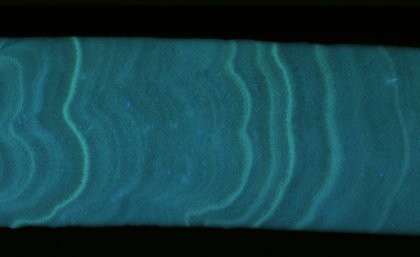
University of Queensland researchers have found physical evidence in Great Barrier Reef corals of a little-known, long-term climate pattern in the Pacific Ocean.
The Pacific Decadal Oscillation – discovered and named only in the 1990s – describes phases of warm and cool sea surface temperatures that alternate between the Pacific Ocean’s east and west, usually over periods of 20 to 30 years.
Lead researcher Dr Alberto Rodriguez-Ramirez, of UQ’s School of Earth Sciences, said the team shone ultraviolet light on longitudinal sections of coral colonies to see their luminescent “growth bands”, and found a record of flood plumes from central Queensland’s Fitzroy River at times coinciding with the Pacific Decadal Oscillation patterns over the past century.
“We have demonstrated that this oscillation pattern is a key driver of river runoff impacting on the Great Barrier Reef,” Dr Rodriguez-Ramirez said.
“Our study suggests that this oscillation will influence the frequency and intensity of future extreme events such as floods – as well as ecological processes – in the region.”
Co-author Professor Jian-xin Zhao, also from UQ’s School of Earth Sciences, said it was well understood that shorter-term phenomenon such as El Niño and La Niña influenced climate in the southern Great Barrier Reef.
“But this work shows that the region also feels the effects of the slower-moving Pacific Decadal Oscillation,” Professor Zhao said.
“This is a significant advance in our understanding of climate variability.”
Co-author Professor John Pandolfi, from UQ’s School of Biological Sciences, said the study examined century-old coral colonies – “bommies” – around the Keppel Islands, 50km from the Fitzroy River mouth.
“As a result of this research, we now know that corals from this area have great potential for reconstructing even longer-term historical evolution of the Pacific Decadal Oscillation,” Professor Pandolfi said.
“Some bommies are five to six metres tall and 400 years old. They can provide us with much longer-term information than is available from satellite-based data, which goes back only 40-50 years.
“This will help refine future models for predicting this important climate phenomenon.”
Dr Rodriguez-Ramirez said that although floods were not new in the region, increased human activity in the Fitzroy catchment since the mid-20th century had increased the impact of extreme weather events on reef ecosystems.
“Our findings are timely, given that extreme weather conditions – associated with La Niña and a ‘negative’ Pacific Decadal Oscillation phase – caused severe negative impacts on human populations along the east coast of Australia in 2011 and 2013,” he said.
After work by other scientists in the 1990s, it is generally understood that a “negative” or “cool” phase occurs when the east Pacific Ocean surface cools and the west warms.
A “positive” or “warm” phase occurs when the pattern reverses.
Like the growth rings found in tree trunks that give year-by-year records of climate and environmental conditions during the tree’s life, longitudinal slices from corals provide a similarly accurate environmental record when viewed under ultraviolet light.
This study produced the first coral core evidence of the massive 2011 floods.
The research was published last week in PLOS ONE, a peer-reviewed, open-access resource produced by the Public Library of Science.
Researchers from NIOZ Royal Netherlands Institute for Sea Research and The University of Western Australia’s Oceans Institute/School of Earth and Environment also worked on the research.
Funding for the project came from the Marine and Tropical Science Research Facility, the NERP Tropical Ecosystems Hub, as well as from the Australian Research Council Discovery Projects scheme, the Endeavour International Postgraduate Research Scholarship scheme, the UQ Living Allowance Scholarship, the UQ Graduate School International Travel Award, and the PADI Foundation.
Contact: Professor John Pandolfi, +61 (0)400 982 3101 (currently in Perth, WA), j.pandolfi@uq.edu.au, Dr Alberto Rodriguez-Ramirez, +61 (0)430303158, alberto.rodriguez@uq.edu.au, Professor Jian-xin Zhao, +61 7 3346 9754, j.zhao@uq.edu.au, UQ Faculty of Science Engagement Manager Julie Baglot, +61 7 (0)411 162 577, j.baglot@uq.edu.au, Engagement Officer Aarti Kapoor, +61 0449 863 208, a.kapoor@uq.edu.au
UWA’s statement on the research is here
.jpg)



